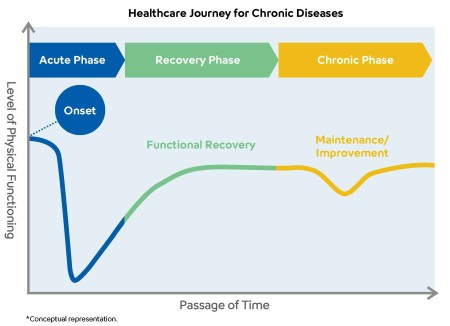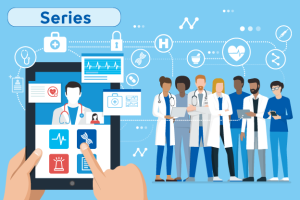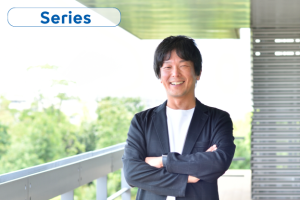Stories
Series: Digital Heathcare Vol. 2
Contributing to Sustainable Community Healthcare through Digital Technology
- Nurse-to-Nurse Collaboration Enhancing Patients’ Innate Strength -
Patients want to live authentic and fulfilling lives in familiar surroundings, even while managing illnesses. To fulfill this wish, strengthening collaboration among various healthcare professionals involved in the patient’s healthcare journey—including acute care, recovery, chronic care, and home care—has become increasingly important. In this article, Seiki Okada, President of D’PULA Medical Solutions (hereinafter “D’PULA”), a Group company of Sysmex, will share how his company is striving to achieve sustainable community-based healthcare through digital technology that enhances collaboration between hospitals and communities.

Why Focus on Collaboration between Hospital and Visiting Nurses?

“When you think of a patient being discharged from a hospital, you might picture them being sent off with a bouquet and a smile. However, for patients with chronic illnesses, discharge marks the beginning of a new stage of living with their condition after overcoming the acute phase. The future of healthcare hinges on how seamlessly we can relay care from hospitals to the community, and I believe that the key to solving this challenge lies in collaboration between hospital nurses and visiting nurses.”
“Nurses play a crucial role in holistic care1 by working alongside doctors to understand the patient’s treatment status and physical condition while also being attuned to the wishes of the patient and their family. However, hospital nurses often have a limited view of the home care situation after discharge, making it challenging to provide care that aligns with the patient’s post-discharge wishes. On the other hand, visiting nurses working in the community offer care that respects the living conditions and values of the patient and their family, but due to insufficient collaboration with specialized hospitals, they face difficulties in providing advanced care.”

Patient-Centered Care Supported by Digital Technology
DX in healthcare is a new social system expected to address issues such as the sharing of medical information and strengthening collaboration among healthcare professionals. The Ministry of Health, Labour and Welfare in Japan defines its purpose as “Changing the shape of society and life so that patients can receive higher-quality treatment and care.” Okada is passionate about exploring what “higher-quality treatment and care” truly entails.
“During my time in the R&D department at Sysmex, I had the opportunity to engage with diabetes patients and the nurses caring for them, which led me to reconsider the significance of testing. For diabetes patients, maintaining blood sugar levels within a normal range and reducing the risk of complications is certainly important. However, they do not live solely for treatment. Patients seek ways to live authentically while managing their illness, and nurses strive to provide care that aligns with the patients’ hopes. As a member of a company involved in people’s health, I have come to strongly feel the need to pursue value that transcends the framework of testing and encompasses an understanding of the entire healthcare journey of the patient.”
A Nurse-to-Nurse Collaboration App to Support Patients’ Healthcare Journey as a Community
2 Hemodialysis and peritoneal dialysis: Both are treatment methods used when kidney function declines and is unable to remove waste products and excess fluid from the body. Hemodialysis involves using a specialized machine to extract blood from the body, remove waste and excess fluid, and then return the cleaned blood back to the body. This procedure is typically performed in hospitals or dialysis centers. Peritoneal dialysis, on the other hand, utilizes the peritoneum in the abdomen. A dialysis solution is injected into the abdominal cavity, and after a few hours, the fluid is drained out, removing unwanted substances from the body. This method can be performed by the patient at home, allowing for greater freedom in daily life.
Empowering Nurses to Enhance Patients’ Innate Strength and Designing New Community Healthcare Models Together


Series: Digital Heathcare
What is Community-Based Healthcare through Decentralized Medical Functions and Enhanced Professional Collaboration?
In Vol. 1 of the “Digital Healthcare” series, we introduce the ongoing efforts in Japan to establish a community-based healthcare system in response to the aging population, as well as the growing importance of regional healthcare collaboration amid the decentralization of medical functions.
Contributing to Sustainable Community Healthcare through Digital Technology
- Nurse-to-Nurse Collaboration Enhancing Patients’ Innate Strength -
In Vol. 2 of the “Digital Healthcare” series, Seiki Okada, President of D’PULA Medical Solutions, a Group company of Sysmex, introduces D’PULA’s current efforts to realize sustainable community-based healthcare through collaboration systems between hospitals and communities.
- Sysmex promotes the concept of a “healthcare journey.” We view the various healthcare-related events a person experiences throughout their lives (life stages), along with the corresponding processes these involve (such as treatment at healthcare institutions), as a “journey.” Through various collaborations, we aim to offer new value, to make each individual’s healthcare journey better, and to grow as an essential presence in society. ”Healthcare journey” is a trademark of Sysmex Corporation, registered in Japan. ▶Short movie "About Healthcare Journey" (Sysmex Corporation’s Official YouTube Channel)
Related Keywords
- Information contained in the stories is current as of the date of the announcement,
but may be subject to change without prior notice.


